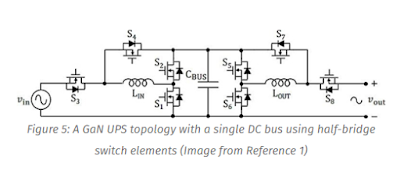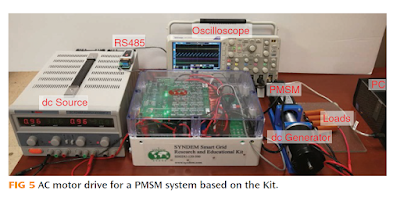Resumo
terça-feira, 22 de dezembro de 2020
DESENVOLVIMENTO DE UPS TRIFASICA DE ALTO RENDIMENTO UTILIZANDO MOSFETS DE CARBONETO DE SILICIO AUTOR WENDELL DA CUNHA ALVES PROGRAMA DE PÓS-GRADUAÇÃO EM ENGENHARIA ELETRICA UNIVERSIDADE FEDERAL DE MINAS GERAIS BRASIL
Resumo
A SiC MOSFET Based High Efficiency Interleaved Boost Converter for More Electric Aircraft Haider Zaman†, Xiancheng Zheng, Mengxin Yang, Husan Ali, and Xiaohua Wu,School of Automation, Northwestern Polytechnical University, Xi’an, China
A SiC MOSFET Based High Efficiency Interleaved Boost Converter for More Electric Aircraft Haider Zaman†, Xiancheng Zheng*, Mengxin Yang*, Husan Ali*, and Xiaohua Wu* †,*School of Automation, Northwestern Polytechnical University, Xi’an, China
Abstract Silicon Carbide (SiC) MOSFET belongs to the family of wide-band gap devices with inherit property of low switching and conduction losses. The stable operation of SiC MOSFET at higher operating temperatures has invoked the interest of researchers in terms of its application to high power density (HPD) power converters. This paper presents a performance study of SiC MOSFET based two-phase interleaved boost converter (IBC) for regulation of avionics bus voltage in more electric aircraft (MEA). A 450W HPD, IBC has been developed for study, which delivers 28V output voltage when supplied by 24V battery. A gate driver design for SiC MOSFET is presented which ensures the operation of converter at 250kHz switching frequency, reduces the miller current and gate signal ringing. The peak current mode control (PCMC) has been employed for load voltage regulation. The efficiency of SiC MOSFET based IBC converter is compared against Si counterpart. Experimentally obtained efficiency results are presented to show that SiC MOSFET is the device of choice under a heavy load and high switching frequency operation.
Key words: High Power Density (HPD), Interleaved Boost Converter (IBC), More Electrical Aircraft (MEA), Peak Current Mode Control (PCMC), Silicon Carbide (SiC)
LINK:https://jpels.org/digital-library/manuscript/file/15794/03_JPE-17-06-083.pdfAnalysis and Implementation of a New Single Switch, High Voltage Gain DC-DC Converter with a Wide CCM Operation Range and Reduced Components Voltage Stress Babak Honarjoo*, Seyed M. Madani†, Mehdi Niroomand*, and Ehsan Adib
Analysis and Implementation of a New Single Switch, High Voltage Gain DC-DC Converter with a Wide CCM Operation Range and Reduced Components Voltage Stress Babak Honarjoo*, Seyed M. Madani†, Mehdi Niroomand*, and Ehsan Adib
Department of Electrical and Computer Engineering, Isfahan University of Technology, Isfahan, Iran
Abstract This paper presents a single switch, high step-up, non-isolated dc-dc converter suitable for renewable energy applications. The proposed converter is composed of a coupled inductor, a passive clamp circuit, a switched capacitor and voltage lift circuits. The passive clamp recovers the leakage inductance energy of the coupled inductor and limits the voltage spike on the switch. The configuration of the passive clamp and switched capacitor circuit increases the voltage gain. A wide continuous conduction mode (CCM) operation range, a low turn ratio for the coupled inductor, low voltage stress on the switch, switch turn on under almost zero current switching (ZCS), low voltage stress on the diodes, leakage inductance energy recovery, high efficiency and a high voltage gain without a large duty cycle are the benefits of this converter. The steady state operation of the converter in the continuous conduction mode (CCM) and discontinuous conduction mode (DCM) is discussed and analyzed. A 200W prototype converter with a 28V input and a 380V output voltage is implemented and tested to verify the theoretical analysis.
Key words: Coupled inductor, High step-up voltage gain, Single switch, Switched capacitor, Low voltage stress
LINK: https://jpels.org/digital-library/manuscript/file/15793/02_JPE-17-04-091.pdf
quarta-feira, 16 de dezembro de 2020
INDUSTRIAL UPS WITH WIDE BANDGAP (WBG) POWER TRANSISTOR devices enable smaller, lighter-weight and more efficient systems
Enter a GaN soft-switching transformer-less online UPS topology which enables significant size reduction by operating efficiently at high switching frequencies using GaN power devices. See Figure 5, at right.
The proposed UPS employs standard GaN half-bridge structures with a common-neutral between the input and output and is able to achieve zero-voltage switching (ZVS) operation, in the boundary conduction mode, with no additional complex circuit design. This design employs a new control methodology for the UPS that has a dual-mode digital controller for the input PFC rectifier stage. The digital controller regulates the output voltage of the converter across both resistive and reactive loads.
The inverter (DC/AC) stage is also operated in dual-mode, and a digital controller regulates the output voltage of the converter across resistive and reactive loads. This converter architecture is capable of delivering 1-kVA of output power while maintaining unity power factor at its input. This GaN-based 1-kVA online UPS is operated using the proposed control technique in Reference 1, and is designed, built, and tested. The prototype UPS, operated up to 2MHz, achieved a power density of 26.4W/in3.
References
1-Control of a GaN-Based High-Power-Density Single-Phase Online Uninterruptible Power Supply, Danish Shahzad, Saad Pervaiz, Nauman Zaffar, Khurram K. Afridi, IEEE 2019
2- Performance Comparison of 1200V Silicon and SiC devices for UPS Application, James McBryde, Arun Kadavelugu, Bobby Compton, Subhashish Bhattacharya, Mrinal Das, Anant Agarwal, IEEE 2010
LINK ORIGINAL:https://gan-sic-power.richardsonrfpd.com/applications/application-industrial-ups/











































 JOSIL ARTISTA PLASTICO FORTALEZA CEARA BRASIL AV.HERACLITO GRAÇA 41 TEL(85)32542378
JOSIL ARTISTA PLASTICO FORTALEZA CEARA BRASIL AV.HERACLITO GRAÇA 41 TEL(85)32542378
















